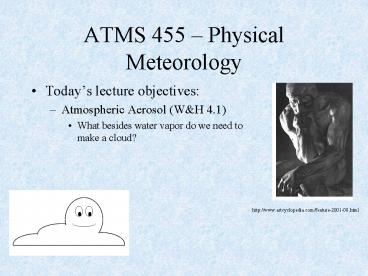Todays lecture objectives: - PowerPoint PPT Presentation
1 / 28
Title:
Todays lecture objectives:
Description:
Today's lecture objectives: Atmospheric Aerosol (W&H 4.1) What besides water ... that aerosol production from human activities will have been twice that in 1968 ... – PowerPoint PPT presentation
Number of Views:57
Avg rating:3.0/5.0
Title: Todays lecture objectives:
1
ATMS 455 Physical Meteorology
- Todays lecture objectives
- Atmospheric Aerosol (WH 4.1)
- What besides water vapor do we need to make a
cloud?
http//www.artcyclopedia.com/feature-2001-08.html
2
ATMS 455 Physical Meteorology
- Todays lecture topics
- Atmospheric Aerosol (WH 4.1)
- Total concentrations
- Size spectra
- Sources and sinks
- Effects on some atmospheric phenomena
3
Introduction
- Cloud physics the study of how raindrops or
snowflakes are formed. - Aerosol ? cloud particle ? hydrometeor
- Hydrometeor precipitation particle (e.g.
raindrop, snowflake, hail, etc.)
4
Introduction
- Atmospheric aerosol important in
- Cloud microphysics
- Air pollution and visibility
5
Total concentrations
- Example of an aerosol collector
6
Total concentrations
- Aitken nucleus counter
- Supersaturates air (wrt water) through rapid
expansion - Droplets are allowed to settle out onto a
substrate - Counted (microscope or using optical techniques)
7
Total concentrations
- Typical values of aerosol
- 103 particles per cubic cm (cc) over oceans
- 104 particles per cc over rural land areas
- 105 particles per cc or higher for polluted air
8
Total concentrations
- Aerosol concentrations decline with increasing
altitude
The surface is an important source of aerosol!
9
Size spectra
- Aerosols range in size from 10-4 micrometers
(10-6 meters) 10-4 x 10-6 10-10 meters to
tens of micrometers - Aerosols range in concentrations from 107 to 10-6
particles per cc - Measurement technique depends on size of aerosol
10
Size spectra
11
Size spectra
- Concentrations of aerosol fall off very rapidly
with increasing size - Relationship is linear for some ranges
- Total concentrations of aerosol are, on average,
greatest in urban polluted air and least in
marine air - Concentrations of giant aerosol (diameters
greater than 2 micrometers) are similar in
continental, marine, and urban polluted air
12
Size spectra
- Giant and large (between 0.2 to 2 micrometer
diameter) aerosols make similar contributions to
the total mass of aerosol in continental air - Aitken nuclei (diameters less than 0.2
micrometers) are large in number, but contribute
only 10-20 to the total mass of aerosol
13
Size spectra
- Surface and volume distribution measurements
14
Size spectra
- More structure than would be expected based on
dN/d(log D) v. log (D) plot - Multiple maxima/minima are associated with
sources and sinks of the aerosol
15
Sources and sinks
- Aitken nuclei (smallest aerosols)
- originate primarily from combustion processes
- also found in marine air (gas-to-particle
conversion) - Sulfur dioxide ? sulfates
- Large and giant nuclei
- Windblown dust, pollens and spores from plants,
bursting of air bubbles over water
16
Sources and sinks
Accumulation mode growth of Aitken nuclei by
coagulation
Coarse particle mode mechanical processes
17
Sources and sinks
- Coarse particle mode over water
18
Sources and sinks
- Coarse particle mode over water
- Drops ejected into the air when air bubbles in
breaking waves burst at the ocean surface - Some drops are thrown 15 cm into the air
- Evaporation of these drops leave behind giant
sea-salt particles - Other bubble bursting processes leave behind
smaller sea-salt particles
19
Sources and sinks
- Differences in aerosol from land and ocean
- Principal aerosol elements are sodium and
chlorine above the sea surface - Dissolve at RH of 95 (see Fig. 4.5)
- Principal aerosol element are silicon, potassium,
and iron above the land surface - Do not dissolve at RH of 95 (see Fig. 4.6)
20
Sources and sinks
By 2000, it was estimated that aerosol production
from human activities will have been twice that
in 1968
21
Sources and sinks
- Aitken nuclei may be converted into larger
aerosol by coagulation - Concentration of aerosol of average diameter 0.01
micrometers should decrease by a factor of two
within 30 minutes due to coagulation (500 h for
0.2 micrometer diameter aerosol to halve their
concentration) - Allows Aitken nuclei to grow to a size that
they can be removed by other mechanisms
22
Sources and sinks
- other mechanisms sinks of aerosols
- Removal by precipitation particles (accounts for
80-90 of the aerosol mass removal) - Diffusiophoretic force capture of aerosols by
cloud particles - Gravitational settling (dry fallout)
23
Sources and sinks
- Summary
24
Effects on some atmospheric phenomena
25
Effects on some atmospheric phenomena
- Atmospheric electricity
- Electrical conductivity of air is a minimum (and
the atmospheric electric field a maximum) when
the concentration of large ions and other Aitken
nuclei is a maximum - Fair weather atmospheric electric field over
cities appears to be related to the level of
aerosol pollution (peak at 7-10am and 7-9pm)
26
Effects on some atmospheric phenomena
- Observed decrease of at least 20 in the
electrical conductivity of the air over the North
Atlantic is attributed to a doubling in the
concentration of Aitken nuclei
27
Effects on some atmospheric phenomena
- Radiative transfer
- Form haze under high RH conditions that reduces
visibility - Absorb and scatter a small fraction of the total
solar radiation passing downward through the
earths atmosphere - Uncertain whether aerosol increase will result in
a net increase or decrease in average global
temperatures
28
Effects on some atmospheric phenomena
- Chemistry
- Solid aerosol provide surfaces upon which trace
gases can be absorbed and then react - Liquid aerosols absorb gases which may then react
together in solution - e.g. sulfur dioxide ? sulfuric acid
- 4000 deaths in London 5-8 Dec 1952 due to dense
smog causing respiratory ailments































